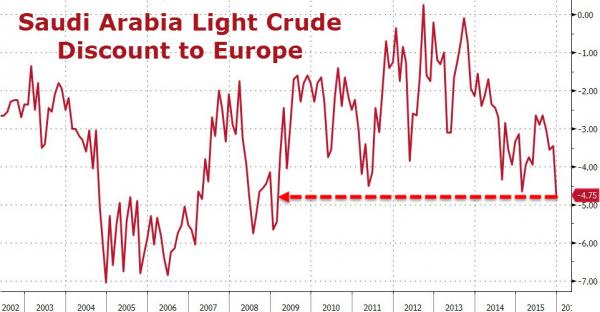With oil exports to Europe having slipped from 13% of Saudi’s total to just 10% in the last six months, The FT reports, the de facto leader of OPEC has slashed its Official Selling Price (OSP) to Europe in an effort to regain market share. Saudi lowered its OSP for its Arab light crude grade in Europe by $1.30 a barrel for December, taking its discount to the weighted average of the North Sea Brent benchmark to $4.75 a barrel – the largest discount since February 2009.
The move, as we detailed previously, is basically going after Russia’s customer base, has raised heckles in Moscow, withRosneft CEO Igor Sechin complaining last month about Saudi “dumping”after he revealed the kingdom was selling oil to refineries in Poland.

Chart: Bloomberg
As The FT reports, the de facto leader of Opec, which produces more than one in every ten barrels of oil in the world, has been squeezed in Europe over the past year as rival producers have sent more oil to the region.
Rising shipments from Iraqi Kurdistan that are delivered into the Mediterranean via the Turkish port of Ceyhan have displaced some Saudi shipments this year, traders and analysts said, while more crude from west Africa is also flowing to Europe.
Saudi Arabia has responded by trying to find new customers,including targeting refineries that have traditionally taken the majority of their supplies from Russia and the North Sea.
The global oil market remains oversupplied by at least 1m barrels a day, a move exacerbated by both Saudi Arabia and Iraq raising production since Opec decided last year to focus on squeezing out higher cost producers rather than defending price.
“If Saudi Arabia and Iraq went back to producing what they were before last November’s Opec meeting, the market would now be in a deficit,” said Paul Horsnell, head of commodities research at Standard Chartered:“The policy can’t be characterised solely as a market share battle. Anything coming into the Mediterranean competes first with Russian and Iraqi crude.”
Russia’s oil output has also risen to post-Soviet era highs in 2015, despite crude prices more than halving to less than $50 a barrel since summer 2014. Russia is also sending more crude into Asia via its Eastern Siberia Pacific Ocean pipeline, increasing competition in those markets.
“ESPO has taken a fair share of Saudi’s market share as well,” one trader said.












Leave A Comment